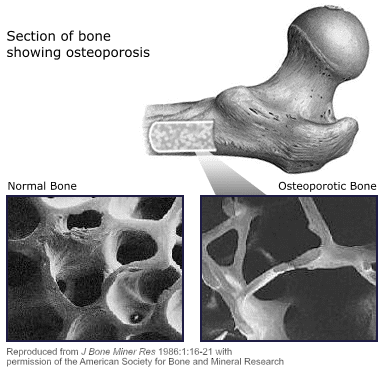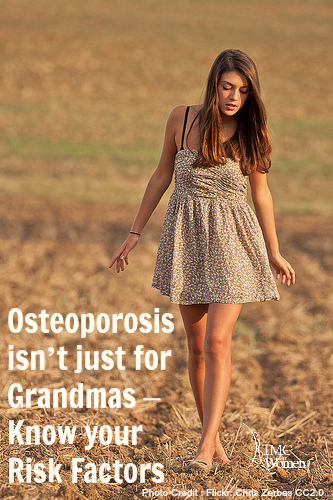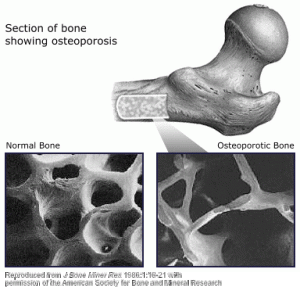
 So here we are again, with good and bad news about risk factors for osteoporosis. Which do you want first? Bad news? Okay. I like to get that over with too.
So here we are again, with good and bad news about risk factors for osteoporosis. Which do you want first? Bad news? Okay. I like to get that over with too.
The bad news is that many of the risk factors are things that you can’t do a thing about, like, well, being female, for example. Other risk factors are being Caucasian, having a family history of osteoporosis, and having a smaller or thinner frame.
Getting older also increases risk of osteoporosis because bone mass declines after early adulthood. Also, estrogen has a protective effect on bones. So menopause, whether it occurs naturally as a woman gets older, or surgically, through removal of the ovaries because of medical necessity, decreases bone density. Alas, though humans have tried to reverse aging for millennia, the fountain of youth is indeed a myth and like it or not, we get older. But keep in mind that getter older is better than the alternative, as they say.
Other risk factors that aren’t an innate part of every woman’s life, but still aren’t simply lifestyle choices are:
- Hyperthyroidism
- Steroid-based medications often used for respiratory illnesses
- Use of selective serotonin reuptake inhibitors (SSRIs) for depression / anxiety
- Use of proton pump inhibitors (PPIs) for acid reflux / GERD
- Antiepileptic medications
- Intestinal disorder
- Cancer
- Rheumatoid arthritis
- Anorexia
The latter is likely a result of depressed estrogen levels. (Estrogen is stored in fat, so being anorexic and having very little fat means the body has minimal amounts of estrogen.) Incidentally, chronically obese women have a lower incidence of osteoporosis for this exact reason ‑ they have more estrogen stored in their bodies. Also, their day-to-day life involves a greater amount of weight-bearing exercise, because, well, they are indeed bearing more weight. This does NOT mean that one should set out to become obese, as the health risks far outweigh (no pun intended) this particular benefit.
Some other risk factors that one has more control over are:
- Smoking
- Excessive alcohol or soda consumption
- Sedentary lifestyle
- Long-term use of injectable progestin-only birth control (Depo Provera)*
*If this is your birth control method of choice, discuss with your gynecologist the pros and cons of this particular hormonal contraceptive. You may decide that it’s still a good choice for you, even with the increased change of osteoporosis. There are risks inherent in many forms of contraception, as well as in pregnancy, so these important decisions should be discussed with your provider.
 How can you find out if you have osteoporosis? As we said in our previous installment, this is a silent disease. If you are wondering if you should be screened for bone density loss, talk with your health care provider.
How can you find out if you have osteoporosis? As we said in our previous installment, this is a silent disease. If you are wondering if you should be screened for bone density loss, talk with your health care provider.
Tucson Medical Center offers state-of-the-art bone scanning technology. The facilities are located near TMC’s breast imaging center, so if you are referred for a bone-density screening, you might be able to schedule it to coincide with your next mammogram. The machine, the GE Lunar 1-DXA, known as DEXA, can scan the back, legs, forearms or the entire body. It can accommodate patients up to 400 pounds, a much higher limit than most scanning machines, and can scan children as well. There is minimal radiation exposure in this type of scanning.
To find out more about bone density screening at TMC check out this page which includes how to schedule an appointment.
Have you had a bone density screening yet?
photo credit: chris zerbes via photopin cc